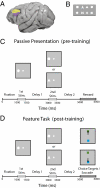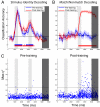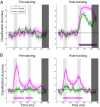Incorporation of new information into prefrontal cortical activity after learning working memory tasks
- PMID: 22392988
- PMCID: PMC3311322
- DOI: 10.1073/pnas.1201022109
Incorporation of new information into prefrontal cortical activity after learning working memory tasks
Abstract
The ability to learn new tasks requires that new information is integrated into neural systems that already support other behaviors. To study how new information is incorporated into neural representations, we analyzed single-unit recordings from the prefrontal cortex (PFC), a brain region important for task acquisition and working memory, before and after monkeys learned to perform two behavioral tasks. A population-decoding analysis revealed a large increase in task-relevant information, and smaller changes in stimulus-related information, after training. This new information was contained in dynamic patterns of neural activity, with many individual neurons containing the new task-relevant information for only relatively short periods of time in the midst of other large firing rate modulations. Additionally, we found that stimulus information could be decoded with high accuracy only from dorsal PFC, whereas task-relevant information was distributed throughout both dorsal and ventral PFC. These findings help resolve a controversy about whether PFC is innately specialized to process particular types of information or whether its responses are completely determined by task demands by showing there is both regional specialization within PFC that was present before training, as well as more widespread task-relevant information that is a direct result of learning. The results also show that information is incorporated into PFC through the emergence of a small population of highly selective neurons that overlay new signals on top of patterns of activity that contain information about previously encoded variables, which gives insight into how information is coded in neural activity.
Conflict of interest statement
The authors declare no conflict of interest.
Figures




References
-
- Miller EK. The prefrontal cortex and cognitive control. Nat Rev Neurosci. 2000;1:59–65. - PubMed
-
- Miller EK, Cohen JD. An integrative theory of prefrontal cortex function. Annu Rev Neurosci. 2001;24:167–202. - PubMed
-
- Duncan J. An adaptive coding model of neural function in prefrontal cortex. Nat Rev Neurosci. 2001;2:820–829. - PubMed
-
- Nieder A, Freedman DJ, Miller EK. Representation of the quantity of visual items in the primate prefrontal cortex. Science. 2002;297:1708–1711. - PubMed
-
- Romo R, Brody CD, Hernández A, Lemus L. Neuronal correlates of parametric working memory in the prefrontal cortex. Nature. 1999;399:470–473. - PubMed
Publication types
MeSH terms
Grants and funding
LinkOut - more resources
Full Text Sources
Miscellaneous

